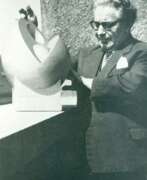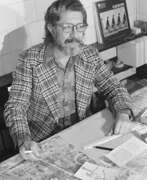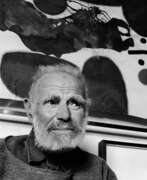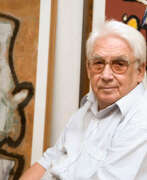Figurative art Constructivism


Victor Servranckx was a Belgian artist renowned for his pioneering contributions to abstract painting and design. Born in Diegem in 1897, Servranckx's artistic journey commenced at the Brussels Royal Academy of Fine Arts, where his studies spanned from 1913 to 1917. It was here he forged a significant connection with René Magritte, leading to their collaborative work "Pure Art: A Defence of the Aesthetic" in 1922.
Victor Servranckx's art is distinguished by its embrace of cubism, constructivism, and surrealism, showcasing a dynamic interplay of geometric forms and innovative design principles. His artistic endeavors were not confined to painting alone; he delved into abstract sculpture and collage, contributing significantly to various art magazines and influencing future generations of artists.
Noteworthy is Victor Servranckx's international recognition, evidenced by his participation in exhibitions across Europe and the United States. His works were exhibited alongside notable figures like Marcel Duchamp and Fernand Léger, highlighting his importance in the art world. Despite a mixed reception in Belgium, his influence endured, culminating in a retrospective at the Musée d'Ixelles shortly before his death in 1965.
For collectors and experts in art and antiques, Servranckx's oeuvre represents a vital chapter in the history of abstract art, offering a window into the evolving artistic trends of the early 20th century. His works, such as "Opus 17-1922" and "Opus 30-1922 (Factory)," are emblematic of his innovative approach and are held in high regard in collections worldwide, including the Museo Nacional Thyssen-Bornemisza.
If Victor Servranckx's artistic vision resonates with you, consider staying updated on exhibitions and auction events featuring his works. Subscribing to updates will ensure you're informed about new opportunities to explore and acquire pieces by this influential artist.


Nikolai Mikhailovich Suetin (Russian: Николай Михайлович Суетин), a pivotal figure in Russian Suprematism, was celebrated for his innovative contributions to art, design, and ceramics. Born in 1897, Suetin's journey into the realms of avant-garde art began under the mentorship of Kazimir Malevich at the Vitebsk Higher Institute of Art. His dedication to Suprematism, an art movement emphasizing geometric forms and pure artistic feeling over representational elements, marked him as one of Malevich's most distinguished disciples.
Suetin's artistry was not confined to painting; he significantly impacted the design of ceramics and porcelain at the State Lomonosov Ceramics Factory, where he applied avant-garde principles to everyday objects, making Suprematism accessible beyond the canvas. His designs for the USSR pavilions at World Exhibitions in Paris (1937) and New York City (1939) showcased his versatility and ability to merge art with architectural spaces, illustrating his belief in the integration of art into daily life.
Notable works by Suetin include "Suprematist Composition with Black Rectangle," "Woman with a White Saw," and the "Scarecrow," along with innovative porcelain designs such as the "Suprematic Inkwell" and the "Tractor" service, embodying the essence of Suprematism through functional objects.
His legacy extends beyond his creations to his influence on the development of Russian modernist aesthetics and his efforts to infuse Suprematism into the fabric of Soviet culture. Suetin's work remains celebrated for its pioneering approach to abstract art and design, holding a permanent place in the annals of 20th-century art history.
For collectors and experts in art and antiques, Nikolai Mikhailovich Suetin represents a unique intersection of revolutionary artistic theory and practical application. His contributions continue to inspire and resonate, emphasizing the power of abstract forms and the potential of art to transcend conventional boundaries.
To stay informed about new product sales, auction events, and updates related to Nikolai Mikhailovich Suetin's work, signing up for updates offers an exclusive insight into the legacy and continued influence of this iconic artist.


Ernest Tino Trova was a self-trained American surrealist and pop art painter and sculptor. Best known for his signature image and figure series, The Falling Man, Trova considered his entire output a single "work in progress." Trova used classic American comic character toys in some of his pieces because he admired their surrealism. Many of Trova's sculptures are cast in unusual white bronze. He began as a painter, progressing through three-dimensional constructions to his mature medium, sculpture. Trova's gift of forty of his works led to the opening of St. Louis County, Missouri's Laumeier Sculpture Park.


Walter Wahlstedt was a German constructivist painter, trained as an artist at the School of Applied Art in Hamburg. Already in the early 1920s he was creating constructive cubist linocuts. He also drew cityscapes and portraits. And in 1922 the Kunsthalle Hamburg acquired a painting by the young artist.











